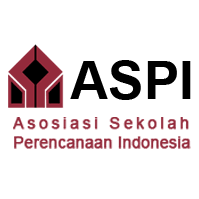Pengendalian Kawasan Terbangun Perkotaan Dengan Optimalisasi Fungsi Hijau Di Kota Depok
Abstract
In Indonesia, order sytems in urban development planning, particularly for the environmental aspects of climate system, is still a static element. There are nearly no considerations to the fact that land cover changes will contribute greatly to the climate systems and its amendments. The Depok climate problem resulted from the land shifts caused by land developments, reduced vegetation density, and the scale of community adaptions. Thus, our research goals include the following:1)Identify the characteristics of land cover changes, land developments, vegetation density and temperature change. 2) Analyze the changing patterns of waking, temperature, density of vegetation and the local community perception of the temperature rise, due to the changes in the land cover. 3.)Develop controls to reduce the rising temperatures. The method of analysis consists of spatial analysis, with remote sensing, to see the development of land, analysis of temperature and density of vegetation, land development pattern analysis, the analysis of overlay areas experiencing an increase in temperature, and analysis of public perception of local climate change and patterns. Analysis is then followed by attempts to control in the direction of lowering the temperature increase.Based on the results of analysis of the land cover, temperature distribution, and vegetation density, it is revealed that the rising temperatures began in the 1990s, and still persists today. Furthermore, our analysis also revealed that the region not only experienced an increase temperature but also an increase in the area of rising temperature since the 1990s. The resulted shift from land waking, along with decreased vegetation density, caused the symptoms of the so called Urban Heat Island (UHI). Our direction is to increase participation in maintaining or adding Green Open Spaces (GOS), which may include green functions, green corridors, and green roofs or canopies.
Keywords: Climate, Land Cover, Vegetation, Public Perception
Downloads
Published
How to Cite
Issue
Section
License
Authors who publish with this journal agree to the following terms:
- Authors retain copyright and grant the journal right of first publication with the work simultaneously licensed under a Creative Commons Attribution License that allows others to share the work with an acknowledgement of the work's authorship and initial publication in this journal.
- Authors are able to enter into separate, additional contractual arrangements for the non-exclusive distribution of the journal's published version of the work (e.g., post it to an institutional repository or publish it in a book), with an acknowledgement of its initial publication in this journal.
- Authors are permitted and encouraged to post their work online (e.g., in institutional repositories or on their website) prior to and during the submission process, as it can lead to productive exchanges, as well as earlier and greater citation of published work (See The Effect of Open Access).


















